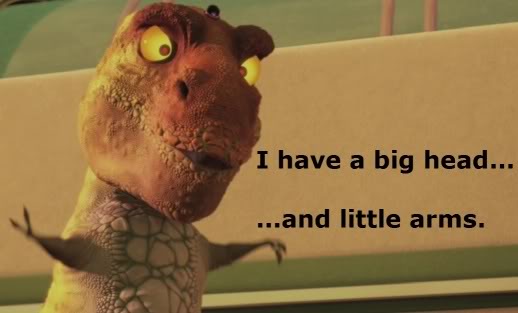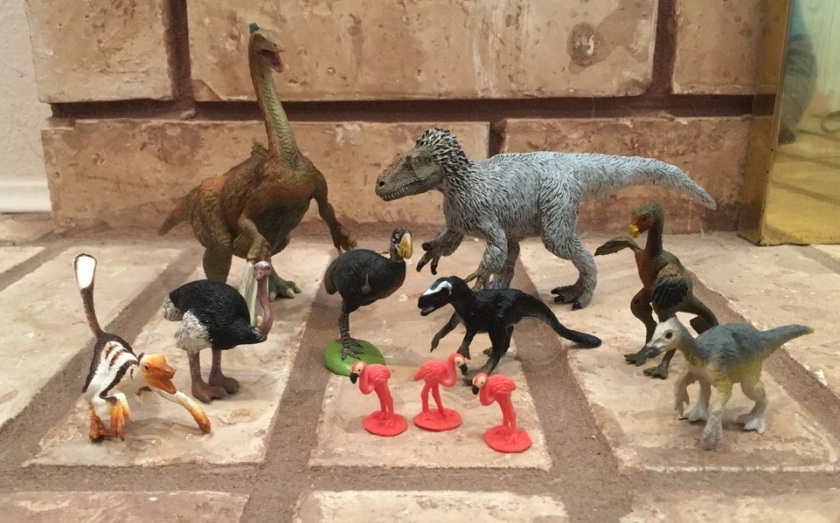While working on the next review, I thought I’d kick off another feature of our website, Dino Fact of the Day! I used to do these all the time in the office at my old job (hi Disney lifeguards!), and I think it’s high time I pick up the tradition again.
In review of “Dinosaur Roar!“, I threw the word “theropod” out there with no real explanation, so today I’ll unpack that a little. In short, all known meat-eating dinosaurs were theropods, though not all theropods ate meat! The word “theropod” itself means “beast foot”; certainly an apt name if ever there was one! Choosing some examples from Jurassic Park (since I’m sure we’re all familiar with that), Tyrannosaurus, Velociraptor, and Dilophosaurus (the “spitter”) were all theropods.
But sharing a diet with your friends doesn’t make you all related, so what actually unites these critters into a single family?
Well, there are numerous skeletal details that really cinch it, but as I don’t want to get too technical in this post, I think we can condense it down to one general concept: bipedalism. While there are exceptions to every other general rule you can make regarding theropods, it seems that all walked on two legs without exception*. Every feature of the theropod body is geared towards this life habit. In fact, this is the primary reason behind the famously small arms of Tyrannosaurus. All theropods relied on holding their tail straight out for balance, and as tyrannosaurs increased the size of their heads (in order to increase the power of their bite), they had to make a trade-off somewhere to stay balanced, and so their arms shrunk in response.

Not that those arms were useless, mind you. Even in the most extreme cases of arm shrinkage, theropods still seem to have been wringing every last possible bit of utility out of them. While the arms of Tyrannosaurus were only about the size of a human’s arms, they were at least twice as strong. And of course some theropods reversed this trend, and developed large, robust arms (along with tiny heads), like Therizinosaurus.
[EDIT] I can’t believe I forgot to talk about bipedal ornithischians (another term for another day)! I guess I only considered larger duckbills and such, which are actually semi-quadrupedal, but most of the smaller herbivores were also bipedal. Again, I don’t want to get too technical, so I’ll go with an easy-to-spot marker. Theropods all have sharp, pointed claws on their feet reflective of their predatory ancestry, even those that made the switch to herbivory. Ornithischians all had far blunter toes, which provided better traction. (Thanks for the comment, Lars!)
There’s much more I could cover, but I don’t want to burn through all my material in one day. I’ll just leave things here for now, and the rest will have to wait for another day. Hope you enjoy the Dino Fact of the Day, and I’ll see you soon with our next book review!

* Okay, well, one possible exception. Some have recently claimed that Spinosaurus had to walk on all four to support itself, but I side with others who aren’t so convinced.


In a future post, you might want to bring up some of the exceptions to this:
• Bipedal non-theropod dinosaurs like most basal ones and pachycephalosaurs.
• Carnivorous (possibly) non-theropod dinosaurs like Herrerasaurs and other basal dinosaurs.
• Abelisaurs (and ratite birds) with vestigial forelimbs.
LikeLike
Thanks for your comment! I can’t believe I completely forgot to at least mention small ornithischians! I’ve updated the post accordingly. Basal dinosaurs are too much of a confusing mess for me to cover at this time, especially since even practicing paleontologists sometimes have trouble deciding which of them belong in what group! Maybe once I’ve got a larger collection of Dino Facts to send my readers back to…
Even with their incredibly reduced forelimbs, I think even Abelisaurs were still wringing some final bit of use out of their arms, given how highly mobile their joints were compared to other theropods. It’s impossible to say what that use was, but there must be a reason their arms didn’t disappear entirely. Ratites are another matter. Some of them DO seem to have completely lost even the bones for their forelimbs, so they must have not had much use for their wings.
LikeLike